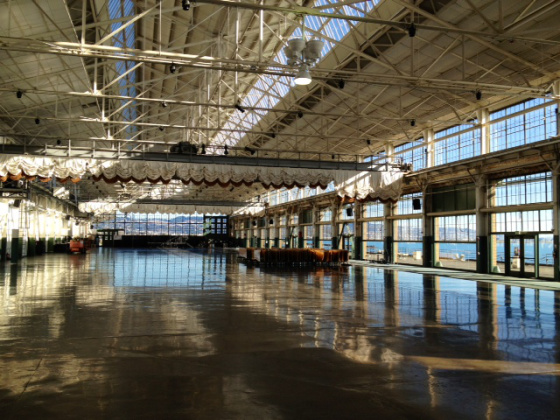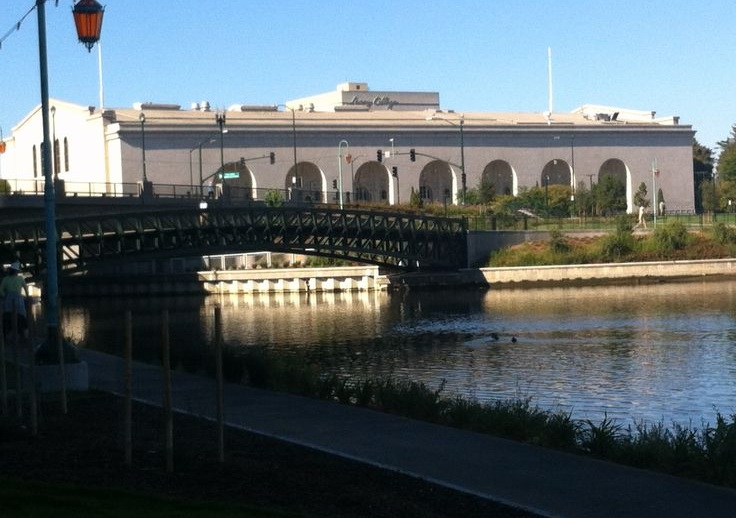|
|
Following Richmond's Lead, For A Change May 26, 2015 Some years ago, I had the opportunity of touring the inside of the old Ford Building on the Richmond waterfront while it was still only the long-abandoned hull of an automobile manufacturing plant. At the time, the City of Richmond was shopping the Ford Building around for a development project. Walking the interior you could see its great potential, with its enormous, high-ceilinged spaces and its spectacular views of the bay and the San Francisco skyline beyond. But amidst the jumble of ruin of rusted pipes and overhanging steel girders and crumbling brick and concrete, it was difficult back then to see what that potential could turn out to be. At least for me. This was still in the era of the real estate boom and for a brief period, Richmond considered turning the property into a vast high-end condominum space, such as Oakland has so often done and continues to do with similar properties. But city officials abandoned that idea in favor of something that would give the general public a chance to enjoy that great space and those views, instead of only (or mostly) those who could afford the price of a down payment. Eventually, Richmond settled on creating a public-private partnership out of the Ford property, a combination of retail stores, restaurants, and enormous open space to be made available for conventions, meetings, performances, and other public events. A smaller adjoining building was set aside to the the Visitors Center for the Rosie The Riveter National Park.
There’s not enough room here to describe the success of that development. If you don’t know, you should ask somebody. Or better yet, you should visit the old Ford Building in Richmond—renamed the Craneway Pavillion—and see for yourself. In a word, it’s spectacular. For years, I’ve been arguing that Oakland ought to follow Richmond’s lead and and look for ways to duplicate that city’s Ford Building strategy. I don’t get listened to much by Oakland officials under any circumstances, but there were a couple of other factors here working against those arguments. The first is that Oakland, for the most part, looks down on Richmond and finds it difficult to imagine that this smaller city just up Highway 880 could possibly be doing anything better than us. The second factor why Oakland officials so often rejected public-friendly development in favor of the private-exclusive—particularly on our waterfront properties—is because of those deep-pocket developers who blow in their ears and continually promise success and riches (in the form of tax benefits, of course, wink-wink) if Oakland only follows their lead in privatizing and gentrifying every available bit of property within the city limits they desire. And so, while I never gave up on my dream of an Oakland that rejects fencing off most of our unused desirable properties from the Oakland public, I figured it would be a long time and a difficult fight for us to ever see some victories on that particular front. And then, one seems to have fallen into our laps without the least bit of a public brawl about it, at all. I’m talking about the City of Oakland’s proposed redevelopment and re-opening of the long-shuttered Kaiser Convention Center just across from the newly-refurbished and revitalized western end of Lake Merritt. Either way you stand and look—from anywhere along the lake across to the Kaiser, or from the Kaiser parking lot across to the lake—thanks to the publicly-financed opening up of the western lake area, it now provides one the most iconic views available anywhere in the city.
The Kaiser Center was closed in 2005, three years after the passage of Measure DD that led to the wonderful improvements at that end of the lake amidst a series of attempts by city officials to privatize the building and its surrounding grounds. As I wrote in an Oakland Post article earlier this year (“Two Developers in Running to Restore Historic Kaiser Convention Center” January 15, 2015) “almost as soon as Measure DD passed in 2002, efforts were made within Oakland city government to sell off the Kaiser property, including a little-known behind-the-scenes proposal to tear down the Kaiser and include it in an aborted plan by the state school administrator to turn the nearby Oakland Unified School District Administration Building into high-rise condominiums during the period when the Oakland schools were under state control.” That was in the years when Oakland schools were under state control, taken over—some of us believed and argued at the time—precisely in order to privatize those publicly-owned western Lake Merritt properties. But the proposal to sell the Kaiser was discarded after the state administrator’s plans to sell off the adjoining OUSD property fell through under the weight of Oakland public pressure, and the Kaiser Center has sat abandoned and falling into deeper disrepair since then, a growing candidate for a possible eventual wrecking ball. Until last fall, that is, when the City of Oakland, without much warning, issued a Notice of Development Opportunity calling for developers to come up with a plan to restore the Kaiser as a public-private space. In my January Oakland Post article, I wrote that “in its original release announcing the Kaiser project, city officials said that ‘while proposals should include the restoration of the existing Calvin Simmons Theater, the city is open to creative and new ideas for the adaptive reuse of the rest of the building, including uses such as performance space, entertainment venues, conference and event spaces, light industrial or maker space, commercial office uses and retail and restaurant space.’” That sounded promising, and very familiar, and so I added that “Oakland’s decision to restore the Kaiser Convention Center as a public-private partnership may have been inspired, in part, by the City of Richmond’s successful restoration of the old Ford Building on that city’s bay waterfront.” I was much closer to the mark than I thought. As the Post article indicated, two companies were and are in the running to win the right to negotiate a deal with the City of Oakland to develop the Kaiser property. The company being recommended by staff to enter into an Exclusive Negotiating Agreement with the city is Orton Development of Emeryville. I hadn’t put the pieces together myself until someone let me know, just this past weekend, that it was Orton that developed the Ford Building/Craneway Pavilion project in Richmond. So Oakland may be poised to follow Richmond’s lead in a way much better than I imagined. I haven’t had the chance to look over Orton’s proposals for the Kaiser building development, not yet. But given the company’s track record in the Richmond project, I find myself more hopeful—cautiously hopeful, but hopeful—about a public development project in Oakland than I have been since, well, since the passage of Measure DD 13 years ago.
|



